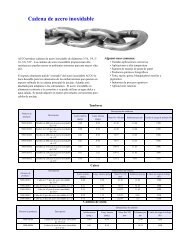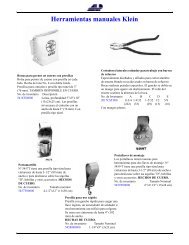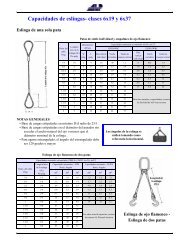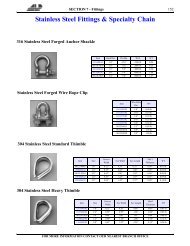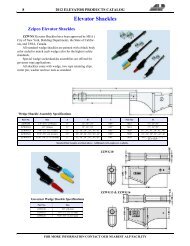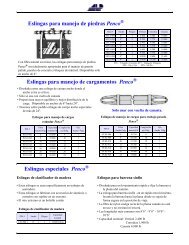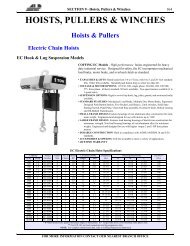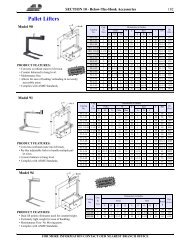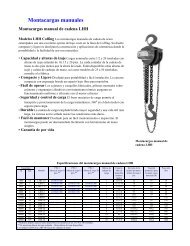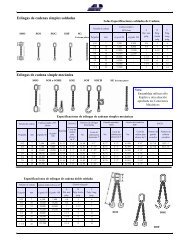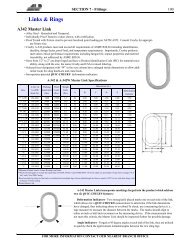General Products - ALP Industries Inc.
General Products - ALP Industries Inc.
General Products - ALP Industries Inc.
- No tags were found...
Create successful ePaper yourself
Turn your PDF publications into a flip-book with our unique Google optimized e-Paper software.
81 SECTION 5 - Synthetic SlingsWeb Sling InspectionInspectionInitial Inspection - Before using any new, repaired, or modified sling, it shall be inspected to ensure that the correct sling is being used aswell as to determine that the sling meets the B30.9-5 Standard.Frequent Inspection - This inspection should be made by the person handling the sling each day the sling is used.Periodic Inspection - This inspection should be conducted by designated personnel. Frequency of inspection should be based on: Frequencyof Use, Severity of Service Conditions, and Experience gained on the Service Life of Slings Used in Similar Applications.Inspection Records - Written inspection records, utilizing the identification for each sling as established by the user, should be kept for allslings. These records should show a description of the new sling and its condition on each periodic inspection.Removal CriteriaA sling shall be removed from service if damage such as the following is visible and shall only be returned to servicewhen approved by a designated person:• missing or illegible sling identification.• acid or caustic burns• melting or charring of any part of the sling• holes, tears, cuts, or snags• broken or worn stitching in load bearing splices• excessive abrasive wear• knots in any part of the sling• excessive pitting or corrosion, or cracked, distorted or broken fittings• red warning yarns are visible in the body of the sling• other visible damage that causes doubt as to the strength of the slingOperating Practices1 Slings having suitable characteristics for the type of load, hitch, and environment shall be selected in accordance withappropriate tables.2 The weight of load shall be within the rated load of the sling. (Sling Angles have a dramatic affect on rated load)3 Slings shall be shortened, lengthened, or adjusted only by methods approved by the sling manufacturer.4 Slings shall not be shortened or lengthened by knotting.5 Slings that appear to be damaged shall not be used unless inspected and accepted as usable under the Inspection and RemovalCriteria.6 Slings shall be hitched in a manner providing control of the load.7 Sharp corners in contact with the sling should be padded with material of sufficient strength to minimize damage to the sling.8 All portions of the human body shall be kept from between the sling and the load, and from between the sling and the cranehook or hoist hook.9 Personnel should stand clear of the suspended load.10 Personnel should not ride the sling.11 Shock loading should be avoided.12 Slings should not be pulled from under a load when the load is resting on the sling.13 Slings should be stored in a cool, dry, and dark place to prevent environmental damage.14 Twisting and kinking the legs shall be avoided.15 Load applied to the hook should be centered in the base (bowl) of hook to prevent point loading on the hook.16 During lifting, with or without load, personnel shall be alert for possible snagging.17 In a basket hitch, the load should be balanced to prevent slippage.18 The sling’s legs should contain or support the load from the sides above the center of gravity when using a basket hitch.19 Slings should be long enough so that the rated load is adequate when the angle of the legs is taken into consideration.20 Slings should not be dragged on the floor or over an abrasive surface.21 In a choker hitch, slings shall be long enough so the choker fitting chokes on the webbing and never on another fitting.22 Nylon and polyester slings shall not be used in contact with object or at temperatures in excess of 194 o F (90 o C) or below -40 o F (-40 o C).23 When extensive exposure to sunlight or ultraviolet light is experienced by nylon or polyester web slings, the sling manufacturershould be consulted for recommended inspection procedure.24Additional information and safe operating practices are outlined in current OSHA and ANSI/ASME B30.9cStandards as applicable, pertaining to Lifting assemblies. Operating practices are outlined in current CommercialVehicle Safety Alliance (CVSA) guidelines for Federal, State, and Provincial practices pertaining toTiedown Assemblies.FOR MORE INFORMATION CONTACT OUR NEAREST BRANCH OFFICE





